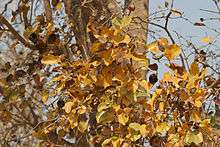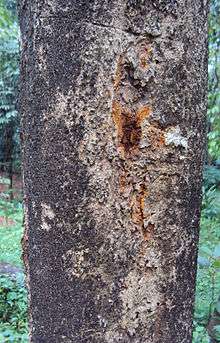Strychnos nux-vomica
Strychnos nux-vomica, the strychnine tree,[2] also known as nux vomica, poison nut, semen strychnos, and quaker buttons, is a deciduous tree native to India and to southeast Asia. It is a medium-sized tree in the family Loganiaceae that grows in open habitats. Its leaves are ovate and 2–3.5 inches (5.1–8.9 cm) in size.[3]
| Strychnos nux-vomica | |
|---|---|
 | |
| Illustration from Köhler's Medizinal-Pflanzen | |
 | |
| Habitus | |
| Scientific classification | |
| Kingdom: | Plantae |
| Clade: | Tracheophytes |
| Clade: | Angiosperms |
| Clade: | Eudicots |
| Clade: | Asterids |
| Order: | Gentianales |
| Family: | Loganiaceae |
| Genus: | Strychnos |
| Species: | S. nux-vomica |
| Binomial name | |
| Strychnos nux-vomica | |
| Synonyms[1] | |
| |
It is a major source of the highly poisonous, intensely bitter alkaloids strychnine and brucine derived from the seeds inside the tree's round, green to orange fruit.[4] The seeds contain approximately 1.5% strychnine, and the dried blossoms contain 1.0%.[3] However, the tree's bark also contains brucine and other poisonous compounds.
Strychnos is promoted within alternative medicine as a treatment for many conditions, but the claims are not supported by medical evidence.[5]
The use of strychnine is highly regulated in many countries, and it is mostly used in baits to kill feral mammals. Most accidental poisoning is caused by breathing in the powder or by absorption through the skin.[6]
Description and properties
Strychnos nux-vomica is a medium-sized tree with a short, thick trunk. The wood is dense, hard white, and close-grained. The branches are irregular and are covered with a smooth ashen bark. The young shoots are a deep green colour with a shiny coat. The leaves have an opposite decussate arrangement (each opposing pair of leaves at right angles to the next pair along the stem), are short stalked and oval shaped, have a shiny coat, and are smooth on both sides. The leaves are about 4 inches (10 cm) long and 3 inches (7.6 cm) wide. The flowers are small with a pale green colour and a funnel shape. They bloom in the cold season and have a foul smell. The fruit are about the size of a large apple with a smooth and hard shell that when ripened is a mild shade of orange in colour. The flesh of the fruit is soft and white with a jelly-like pulp containing five seeds covered with a soft, woolly substance.
The seeds have the shape of a flattened disk completely covered with hairs radiating from the center of the sides. This gives the seeds a very characteristic sheen. The seeds are very hard, with a dark gray horny endosperm where the small embryo is housed that gives off no odor but possesses a very bitter taste.
Ecology
The fruit is eaten by monkeys and birds, such as the gray langur.[7]
Uses
The strychnine-containing seeds have been used in arrow poison.[7]
Herbalism

Strychnos is promoted within herbal medicine as being a treatment for a wide range of maladies, including cancer and heart disease.[5] There is, however, no evidence it is useful for treating any condition.[5] Indeed, these seeds contain strychnine poison. The plant appears on the Commission E list of unapproved herbs because it has not been proven to be safe or effective and thus is not recommended for use.
In Ayurveda (the Indian system of folk medicine), hudar is a mixture containing Strychnos nux-vomica. The seeds are first immersed in water for five days and then in milk for two days followed by their boiling in milk.[8]
The level of toxic alkaloids in the unprocessed Strychnos seeds used in traditional medicines can be determined using established HPLC methods and HPLC-UV methods.[9]
References
- "Strychnos nux-vomica L." The Plant List.
- "Strychnos nux-vomica". Natural Resources Conservation Service PLANTS Database. USDA. Retrieved 4 December 2015.
- Harry L. Arnold (1968). Poisonous Plants of Hawaii. Tokyo, Japan: Charles E. Tuttle. p. 20. ISBN 0-8048-0474-5.
- Oudhia, P., 2008. Strychnos nux-vomica L. [Internet] Record from PROTA4U. Schmelzer, G.H. & Gurib-Fakim, A. (Editors). PROTA (Plant Resources of Tropical Africa / Ressources végétales de l’Afrique tropicale), Wageningen, Netherlands.
- Ades TB, ed. (2009). Strychnos nux-vomica. American Cancer Society Complete Guide to Complementary and Alternative Cancer Therapies (2nd ed.). American Cancer Society. pp. 504–507. ISBN 9780944235713.
- "Drugs and Poisons Fact Sheet: Strychnine Permits - What you need to know" (PDF). Queensland Health. December 1, 2011. Archived from the original (PDF) on November 13, 2013.
- Hargreaves, Dorothy; Hargreaves, Bob (1970). Tropical Trees of the Pacific. Kailua, Hawaii: Hargreaves. p. 59.
- Seema Akbar, Shamshad A Khan, Akbar Masood & M Iqbal (2010). "Use of Strychnos nux-vomica (azraqi) seeds in Unani system of medicine: role of detoxification". African Journal of Traditional, Complementary and Alternative Medicines. 7 (4): 286–290. PMC 3005396. PMID 21731158.CS1 maint: multiple names: authors list (link)
- Q. B. Han, S. L. Li, C. F. Qiao, J. Z. Song, Z. W. Cai, P. Pui-Hay But, P. C. Shaw & H. X. Xu (2008). "A simple method to identify the unprocessed Strychnos seeds used in herbal medicinal products". Planta Medica. 74 (4): 458–463. doi:10.1055/s-2008-1034359. PMID 18484543.CS1 maint: multiple names: authors list (link)
| Wikimedia Commons has media related to Strychnos nux-vomica. |